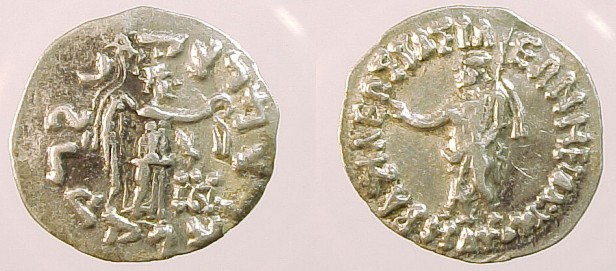

A drachma of the early Indo-Scythian or Shaka king Maues (r. c.90-60 BCE), who ruled in Gandhara; the left-hand image shows Kharoshthi script
Source: http://www.coincollecting.ch/041500auctioncat2.html
(downloaded Mar. 2004)
"Maues, c. 90-80 BC, drachm 2.44g, Standing figure of Zeus / Nike standing,
facing right."
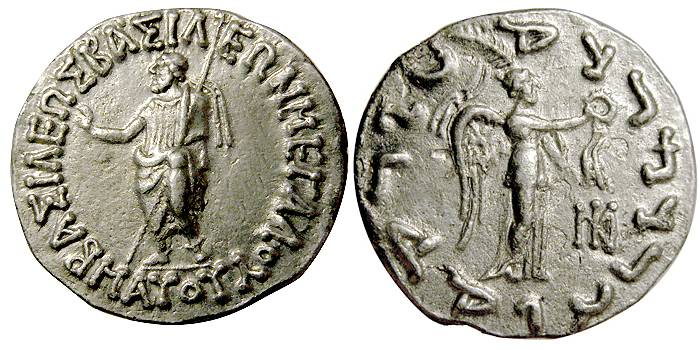
Another of Maues's coins, with Kharoshthi script on the right-hand face of the coin
Source: http://www.vcoins.com/ancient/lodgeantiquities/store/viewItem.asp?idProduct=2766&large=1
(downloaded Jan. 2006)
"Scythian Kingdom in Pakistan, Maues, 90-57BC, AR Tetradrachm. Zeus standing facing left, holding sceptre. / Nike advances right, holding wreath."
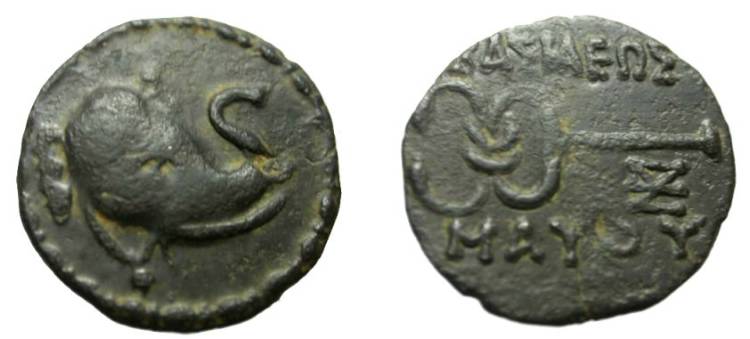
A smaller coin of Maues's, with an elephant head on one side and a Greek caduceus on the other
Source: http://www.vcoins.com/ancient/ancientbyways/store/viewItem.asp?idProduct=1560&large=1
(downloaded Jan. 2006)
"Scythian Kingdom in Pakistan, Maues, 90-57BC, AE Dichalkon or Hemiobol. Elephant head facing right / Caduceus. Kohat mint."
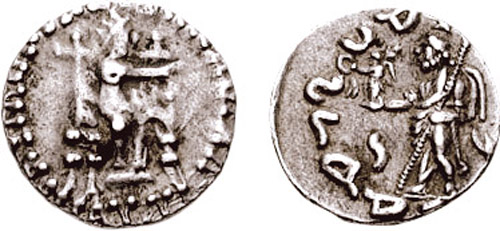
One more bilingual and bicultural example from Maues
Source: http://www.cngcoins.com/Coin.aspx?CoinID=57593
(downloaded Mar. 2006)
"Maues. Circa 95/85-65/60 BC. AR Drachm (2.45 gm, 12h). Mint in Hazara-Kashmir region. BASILEWS BASILEWN MEGALOU MAUO[U], Tyche enthroned facing slightly right, holding torque in her outstretched right hand, sceptre in his left / "Rajadorajasa Mahatasa Moasa" in Karosthi, Zeus standing left, holding Nike in his outstretched right hand, sceptre in his left; control mark to left."
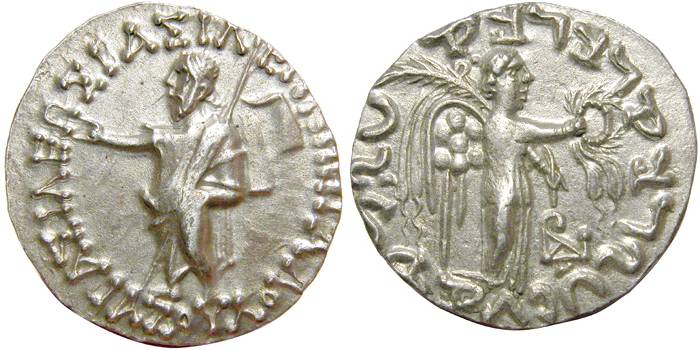
A coin of Azes I (r. c.57-35 BCE), with Greek and Kharoshthi inscriptions
Source: http://www.vcoins.com/ancient/lodgeantiquities/store/viewItem.asp?idProduct=2638&large=1
(downloaded May 2006)
"AZES I. AR tetradrachm. 100 - 65 B.C. Obverse: King standing left holding sceptre. Reverse: Nike standing right holding wreath & palm."
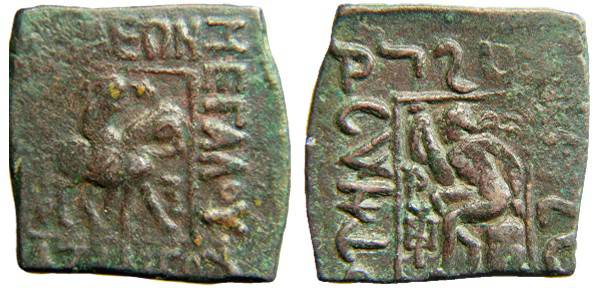
Azilises, who reigned as co-king with Azes I, gave himself, in Kharoshthi script, titles that included the Indic "Maharajasa Rajarajasa"
Source: http://www.vcoins.com/ancient/dltcoins/store/viewItem.asp?idProduct=974&large=1
(downloaded May 2006)
"Indo-Scythians, Azilises, c. 58-35 BC, Square AE23 Trichalkon. Herakles.
Square AE22 Trichalkon. Date Struck c. 58-35 BC. Mint Taxila
(?). Obverse BASILEWS BASILEWN MEGALOU AZILISOU. King on horseback
right. Reverse Kharosthi legend: Maharajasa Rajarajasa Mahatasa Ayilishasa.
Herakles seated left on rock with club and lion skin, monograms in field.
Weight 7.13gm. Diameter 23x22mm."
[Image and description courtesy of *David
L. Tranbarger Rare Coins*.]
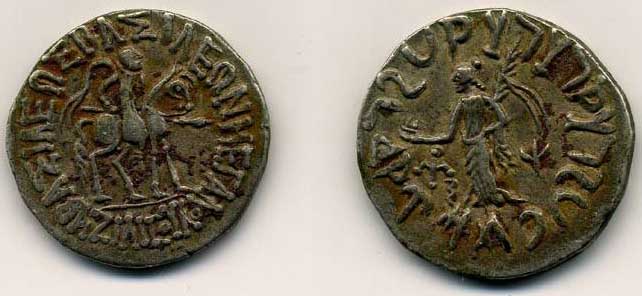
The Kharoshthi on many of Azilises's coins is particularly clear and elegant
Source: http://www.vcoins.com/ancient/mnm/store/viewItem.asp?idProduct=224&large=1
(downloaded May 2006)
"Azilises 57-35 BC. Tetradrachm. Obv - King holding spear, mounted on horse walking right. Greek legend. Rev - City Goddess standing left holding palm and lamp. Control marks in field. Kharosthi legend."
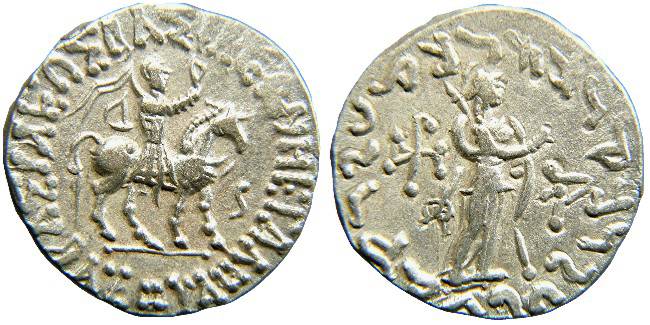
Another Greek-Kharoshthi coin, this one by Azes II (r. c.35-12 BCE); on it he gave himself Sanskritic titles in Kharoshthi script
Source: http://www.vcoins.com/ancient/dltcoins/store/viewItem.asp?idProduct=965&large=1
(downloaded Jan. 2006)
"Indo-Scythians, Azes, c. 58-19 BC, AR Tetradrachm. Pallas. Date Struck
c. 58-19 BC. Undetermined mint in Gandhara, west of Taxila. Obverse
BASILEWS BASILEWN MEGALOU AZOU. King on horseback right, holding whip;
monogram before. Reverse: Kharosthi legend. Maharajasa Rajadirajasa
Mahatasa Ayasa. Pallas standing right, holding shield and spear; monograms
at left and right. Although early references tend to attribute this series
of coins to two rulers, Azes I and Azes II, it is now generally accepted
that there was only one Azes, who was succeded in Gandhara by the Indo-Parthian
Gondophares circa 19 BC."
[Image and description courtesy of *David
L. Tranbarger Rare Coins*.]
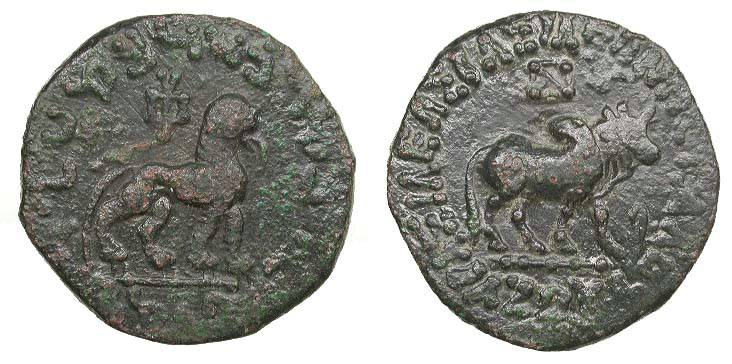
Azes II also issued this very Indic zebu-adorned "hexachalkon" coin
Source: http://www.vcoins.com/ancient/civitas/store/viewItem.asp?idProduct=3470&large=1
(downloaded May 2006)
"Indo-Scythians Azes as Rajadirajasa. Circa 57-20 BC Æ Unit 14.69g. 26mm. Taxila mint? Humped bull Zebu standing right; monograms above. BASILEWS BASILEWN MEGALOU AZOU. Lion standing right; monograms above."
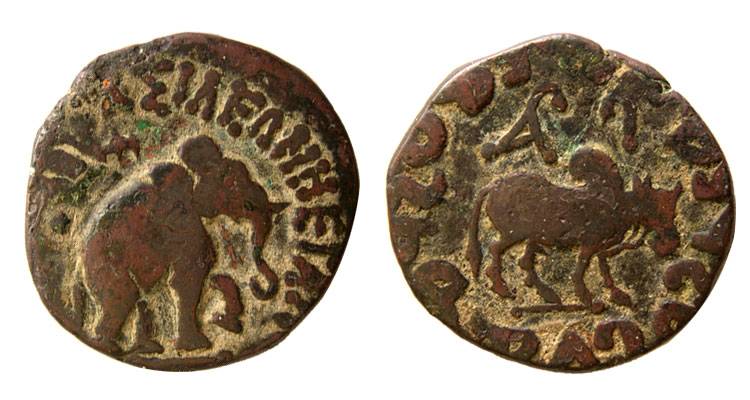
On his "pentachalkon" coins, Azes II displayed not only a zebu but also an elephant
Source: http://www.vcoins.com/ancient/parscoins/store/viewItem.asp?idProduct=3657&large=1
(downloaded Oct. 2006)
"Indo-Scythian: Azes II / AE pentachalkon. (11.39 gm; 24 mm). Hazara mint. Early issue struck 35-30 BC. Elephant standing right / Bull standing right."
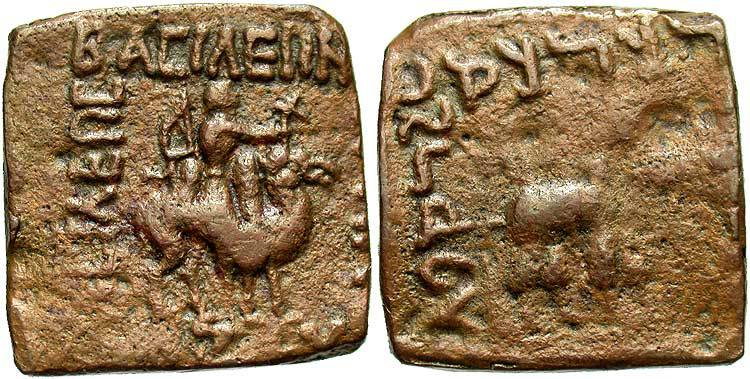
Here Azes rides a camel; the humped bull on the other face is barely discernible
Source: http://www.vcoins.com/ancient/saylesandlavender/store/viewItem.asp?idProduct=2379&large=1
(downloaded Oct. 2006)
"Indo Scythian, Azes I: King on Camel / Humped bull. ca. 57-35 BC, AE, 25mm, hexachalkon. King on camel right / Humped bull right."
| == INDIAN ROUTES index == sitemap == Glossary == FWP's main page == |